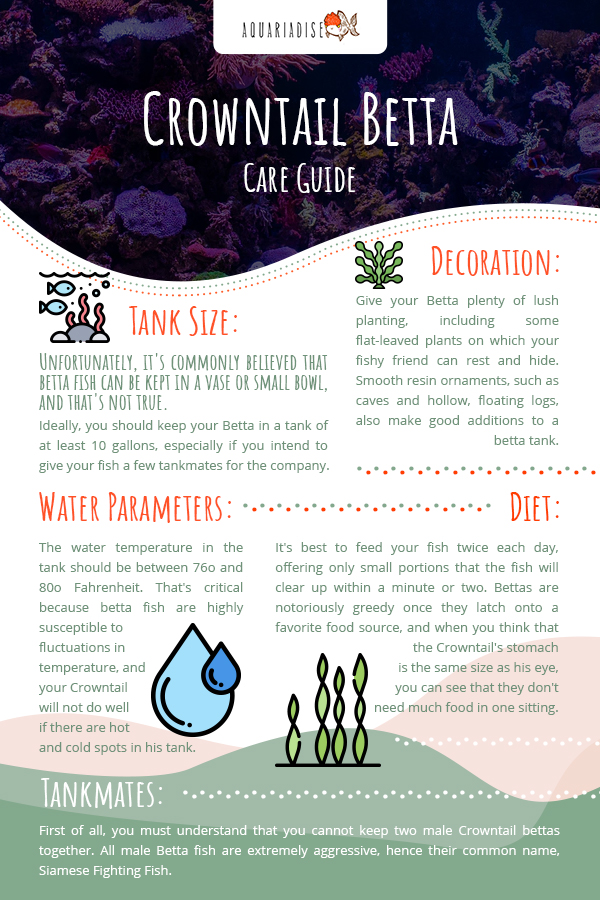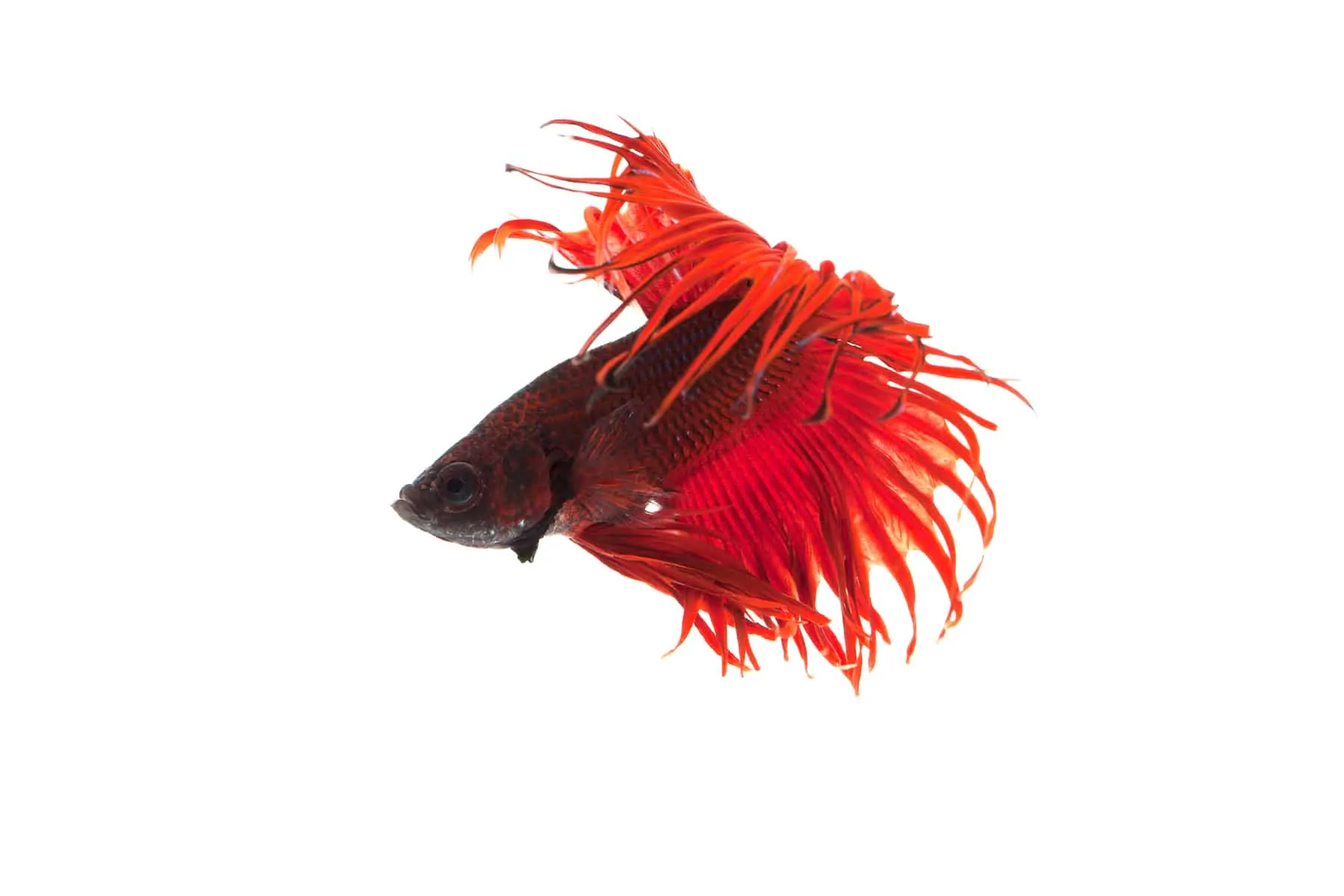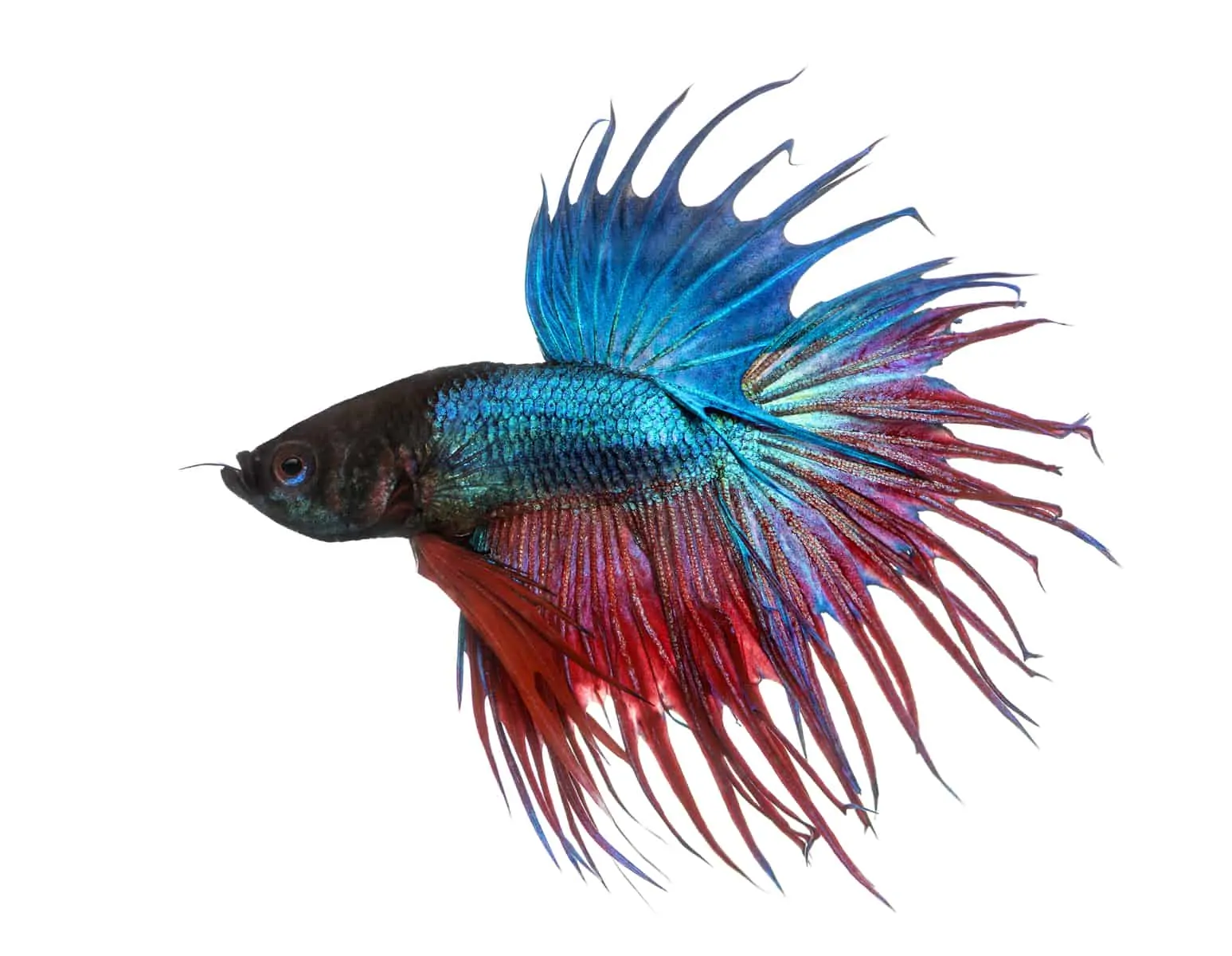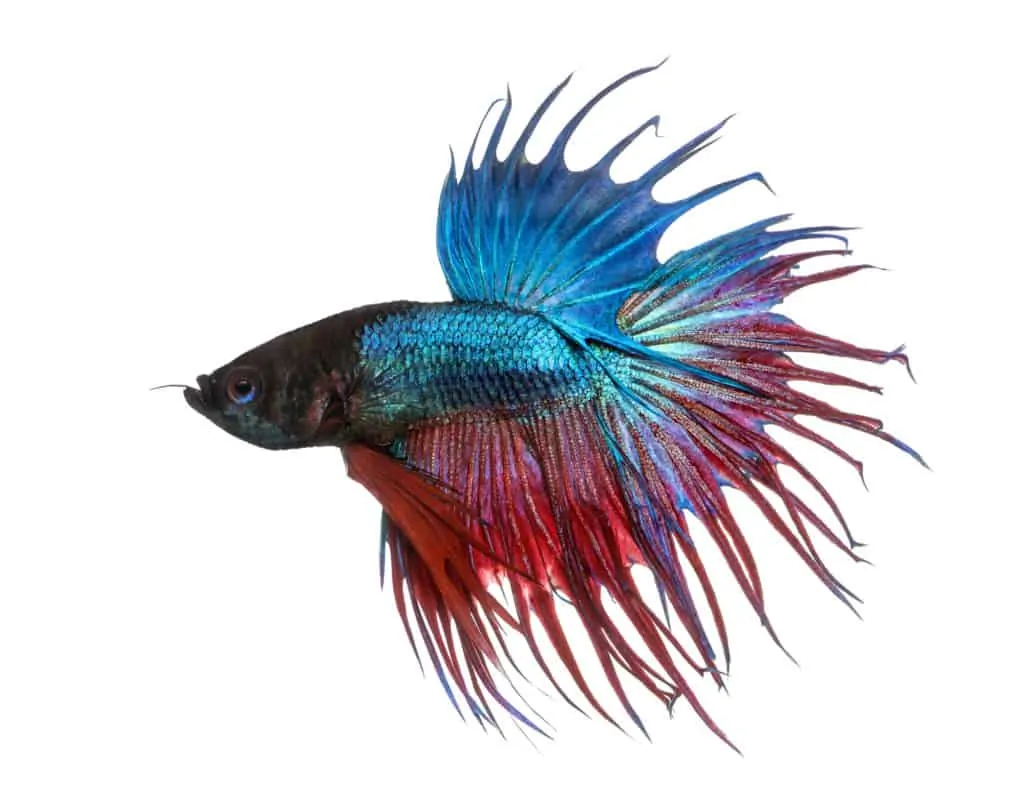The Crowntail Betta is a truly beautiful fish that’s one of the most popular choices among hobbyists in the U.S. and around the world, largely because of their incredible caudal or tail fin!
Crowntails are a variety of Betta splendens. These spectacular tropical fish are relatively easy to care for, as long as you give them a balanced, nutritious diet, the correct tank conditions, and suitable tankmates.
In this guide, we tell you everything that you need to know about caring for and breeding Crowntail bettas.

Origins
The Crowntail betta splendens is a captive-bred variant of the wild Placat Betta or Siamese Fighting fish.
Placats are small, stocky fishes that were raised specifically for the “sport” of fish fighting and are bred to be particularly aggressive toward their own kind.
Bettas are found in southeast Asia, specifically the Malayan peninsular, Mekong Basin, Vietnam, Thailand, and Cambodia. The fish live in slow-moving or stagnant waters, typically in rice paddies, canals, shallow streams, and small ponds, feeding on insect larvae and water-bound insects.
The Betta is currently listed on the IUCN Red List as a “Vulnerable” species. Unfortunately, the precise extent of decreasing numbers of wild Betta splendens is not known, but much of its known habitats have been converted for industrial-scale farming, leading to degradation and pollution of the waterways, especially in central Thailand.
Further threats to the native Betta population exist in the form of genetic erosion caused by hybrid, farmed variants of the species that have released into the wild and are free to mate with wild fish.
Crowntail betta history
The Crowntail Betta is a variety of Betta splendens. These fish don’t exist in a wild environment, having been engineered and bred in captivity specifically for the hobby and for show.
Crowntails were first produced by the Indonesian breeder, Achmad Yusuf, in 1997, whose first fish was given the name, “Cupang Serit.”
Like all male betta fish, Crowntails are renowned for being super-aggressive toward other male Siamese Fighting fish and other brightly colored species of fish that have long flowing fins. A Crowntail will even attack his own reflection, mistaking it for another male in his territory.

Appearance
Crowntails grow to measure around 2.5 inches in length, although you can add an extra few inches for the caudal tail fin!
The fish’s caudal (tail fin) is its most eye-catching feature. The caudal has huge extensions that can be as large as 8 inches in diameter, almost three times the size of the fish’s body! The webbing in the tail is dramatically reduced, with the spiky rays giving the caudal a dramatic “crown tail” appearance, hence the fish’s name.
The most common colors that you’ll see in Crowntail bettas are different shades of red and blue, although there are other colors too, including a rather sinister-looking black variant.
Betta fish are surface feeders, having an upturned mouth that contains tiny, sharp white teeth that the fish uses in the wild environment to grab and secure water-bound insects and insect larvae.
Male bettas have an opercular membrane or beard that’s situated under the gill plate cover. The beard is most obvious when the fish is flaring, although it’s also visible when the fish is relaxed.
Betta fish enjoy a typical lifespan for small tropical fish of around two to three years.
Care of the Crowntail Betta
One of the reasons that bettas are so popular is that they are relatively easy to care for, even for novice hobbyists.
Here’s how to look after your beautiful Crowntail so that he thrives.
Tank size
Unfortunately, it’s commonly believed that betta fish can be kept in a vase or small bowl.
Not so!
Like any species of fish, bettas need clean, properly filtered, and heated water if they are to thrive. Ideally, you should keep your Betta in a tank of at least 10 gallons, especially if you intend to give your fish a few tankmates for the company.
Wild betta fish have a territory of around 3 square feet. So, you can see how cramped and unsatisfactory a bowl or vase would be.
Betta fish related to the gourami family of fishes, and, as such, they are labyrinth breathers. That means that the fish can breathe air from the water surface when oxygen levels are poor, as sometimes happens during the dry season in the Betta’s wild habitat. So, you need to choose a tank that provides plenty of surface area.
Although the Crowntail Betta boasts a spectacular tail fin, that can be a real handicap when the fish is trying to swim to the surface to feed or to breathe. For that reason, it’s best to choose a shallow, long tank rather than a tall, deep one.
In the wild environment, bettas sometimes find themselves living in puddles, especially during the dry season. So, the fish has evolved the ability to jump, enabling it to relocate when necessary. Captive-bred bettas can jump too, so always choose a tank with a cover slide or tightly fitting lid.
Tank decoration
Betta fish are intelligent creatures that enjoy an environment that contains plenty of things to explore and investigate.
It’s also well-known amongst betta enthusiasts that these fish can become bored. Boredom leads to stress, which predisposes the fish to become lethargic and stop eating. So, give your Betta plenty of lush planting, including some flat-leaved plants on which your fishy friend can rest and hide. Smooth resin ornaments, such as caves and hollow, floating logs, also make good additions to a betta tank.
The substrate and any decorations that you use in a betta tank should be soft and smooth so as not to damage the Crowntail’s luxuriant finnage.
Keep lighting levels on the dim side. Floating plants are great for diffusing light and for encouraging your fish to build a bubble nest, as he would in the wild. The addition of a handful of Indian almond leaves to the tank can have beneficial effects for your Crowntail Betta’s health.
Water parameters
Siamese Fighting fish are freshwater fish. For your Crowntail to remain in good health, you’ll need to give him the best conditions in his tank.
The water temperature in the tank should be between 76o and 80o Fahrenheit. That’s critical because betta fish are highly susceptible to fluctuations in temperature, and your Crowntail will not do well if there are hot and cold spots in his tank. In fact, temperature shock is a known killer of betta fish, so you must pay close attention to this aspect of the tank environment.
Place the heater close to the pump outlet so that the heat is circulated around the tank, helping to keep the temperature constant throughout the environment. You can check for hot and cold areas by placing your tank thermometer at the end of the tank that’s furthest away from the heater. If the temperature shown by the thermometer is constant, you’ll know that the warmth is evenly distributed around the aquarium.
pH levels should be between 6.4 and 7.0, and the water hardness should be between 2 to 5 dKH.
Make it part of your maintenance routine to check the levels of ammonia, nitrite, and nitrate in your tank every week, as well as changing up to 30% of the water.
Diet and nutrition
Crowntail betta fish are mostly carnivorous and require a high protein diet to thrive.
It’s best to feed your fish twice each day, offering only small portions that the fish will clear up within a minute or two. Bettas are notoriously greedy once they latch onto a favorite food source, and when you think that the Crowntail’s stomach is the same size as his eye, you can see that they don’t need much food in one sitting.
Overfeeding your fish can cause significant health problems, including bloat, constipation, and dropsy. Also, uneaten food will decompose, polluting the water, and placing a greater burden on your filtration system. For that reason, most experienced fish keepers recommend not feeding your betta fish for one day per week. That allows the fish’s digestive system to process any food that’s still passing through it before more is added.
Bettas enjoy a varied diet of pellets, flakes, live, and frozen food. The Crowntail Betta can be a fussy eater, and you may need to try several different brands of food before you find one that your fish will accept. Generally, betta fish will eat bloodworms, mosquito larvae, brine shrimp, blackworms, and wingless fruit flies.
Tankmates
Bettas are naturally solitary fish that don’t need company, as long as you provide them with plenty of interest and mental stimulation in their aquarium and through feeding them properly. However, there’s no doubt that a community tank can look even more beautiful with a Crowntail betta as its centerpiece.
So, what about tankmates for the betta fish?
First of all, you must understand that you cannot keep two male Crowntail bettas together.
All male Betta fish are extremely aggressive, hence their common name, Siamese Fighting Fish. Although it may be impressive to see two male bettas flaring and displaying at each other, that behavior is very stressful for the fish, and they generally fight to the death.
A small group or sorority of female betta fish can make suitable companions for a male betta, especially if you want to breed from him. However, even females can be aggressive, and sisterhood is not always without problems.
That said, you can keep other fish species peacefully with your Crowntail Betta, as long as you choose tankmates carefully.
As a general rule, avoid species that are known to be aggressive fin nippers. Also, fast-swimming fish can trigger attack mode in male bettas, as do very brightly colored species such as Guppies and Neon tetras. You also need to avoid introducing species that like to hang out in the upper area of the water column. That’s the Betta’s preferred territory, and introducing another species here can lead to disputes.
So, you’re primarily looking at bottom-dwellers such as Corydoras catfish and other species of small catfish. Snails and large species of shrimp can also be a nice addition to the tank, as they are entertaining to watch, and they contribute to the housekeeping in the tank by eating algae, dropped scraps of food, and general detritus.
If you are introducing your Betta to an existing tank setup, place the fish in a transparent plastic cup and allow the cup to float on the surface for half an hour or so. Observe the Betta see how he reacts to the presence of the other fish. When the Betta is calm, introduce him to the tank, but continue to watch closely for signs of aggression.
Bettas are actually quite shy fish, and the new arrival will most likely hide for the first day or so until he becomes more confident.

Breeding
Crowntail bettas are bubble nesters, and they’re relatively straightforward to breed in a tank setting.
The male fish creates a nest by blowing bubbles, usually in the corners of the tank or underneath floating plants. The male and female spawn under the nest with the male curling around the female. The eggs are released in twos and threes, and the male fertilizes them. The parents then collect the eggs and place them carefully into the bubble nest.
The fry emerges within 48 hours and remains attached to the egg, feeding on the yolk sac for a further two or three days. Once free-swimming, you can feed the fry with infusoria for a few days, graduating to Artemia and micro-worms.
While the fry is growing, you must ensure that the tank has a tight cover slide or lid to create a layer of warm, humid air, which is essential for the healthy development of the labyrinth organ.
Breeding from your male Betta can become quite addictive as you learn more about betta genetics and try to create exciting new variants on this beautiful, enigmatic fish.
Diseases
Crowntail bettas can be susceptible to a few diseases that are common to most freshwater fish species. Most of these health problems are caused by a poor diet and incorrect or unsanitary water conditions.
Ich
Ich is also known by its common name of White Spot Disease.
Ich is caused by the Ichthyophthirius multifiliis parasite, a protozoan creature that is present in most freshwater fish tanks, causing no problems until the fish are weakened by disease or poor water conditions. Ich is usually first noticed as a rash of tiny white spots across the fish’s body, fins, and gills. Affected fish often clamp their fins, flick or rub against objects within the tank, and may hang listlessly at the surface of the water.
Ich can be treated quite easily with an over-the-counter treatment that you add to the aquarium water. At the same time, raise the temperature to 82o Fahrenheit for four days to disrupt the parasite’s lifecycle.
This two-pronged attack will kill the Ich parasite in the tank and on the fish.
Constipation
Constipation is usually caused by overfeeding or by feeding the fish an incorrect diet.
Your Crowntail Betta may appear swollen and lethargic and won’t want to eat. Usually, fasting the fish for 48 hours allows time for the fish’s digestive system to process any food that’s left inside it. You could also try offering a small portion of live food, which often helps to get things moving again.
Availability
Crowntail betta fishes are one of the most popular variants of the Betta splendens, and they are easy to breed in captivity. For that reason, you’ll find these fish for sale in most good fish stores.
If you’re looking for a very unusual coloration in a specimen with a view to breeding from your fish, you may find something suitable at one of the many online dealers’ websites. Alternatively, you could take a look at the auction site, Aquabid.com, where an unusual golden betta sold for a record price of $1,500 some years ago.
However, the typical cost of a standard red or blue Crowntail betta is usually around $5 to $30, depending on the size, vibrancy of color, sex, and where you buy your fish. Remember that, although buying online has advantages, you will have to pay shipping costs, and you can’t see your fish “in person” before it arrives.
In summary
The Crowntail Betta is a beautiful fish with a flowing, spiky tail fin that resembles a crown.
These gorgeous fish are relatively easy to care for and do best in a tank of more than 10 gallons. Male bettas are generally happy to live alone, although you can introduce a few well-chosen tankmates if you want to without too much drama.
Crowntail bettas make a great breeding project too for those who fancy a fascinating challenge. But be warned. Many hardcore Betta enthusiasts start with one male Betta fighting fish and finish up with a lifelong addiction to this interesting and characterful creature.


